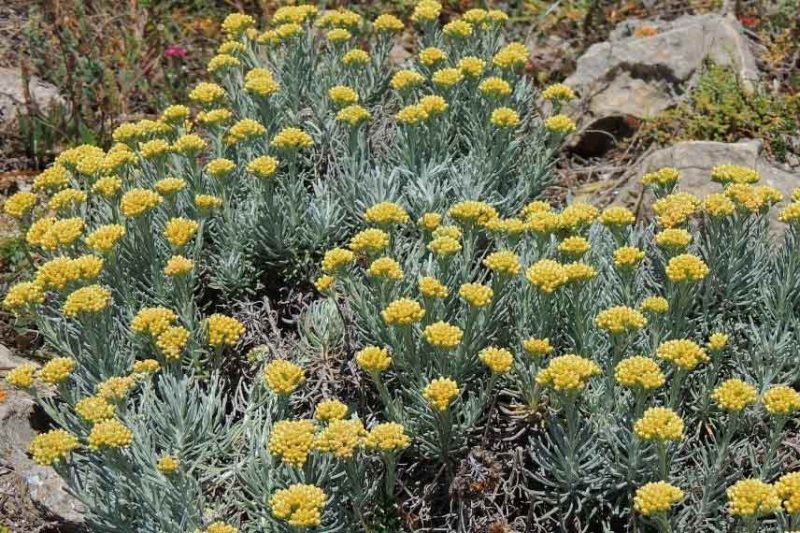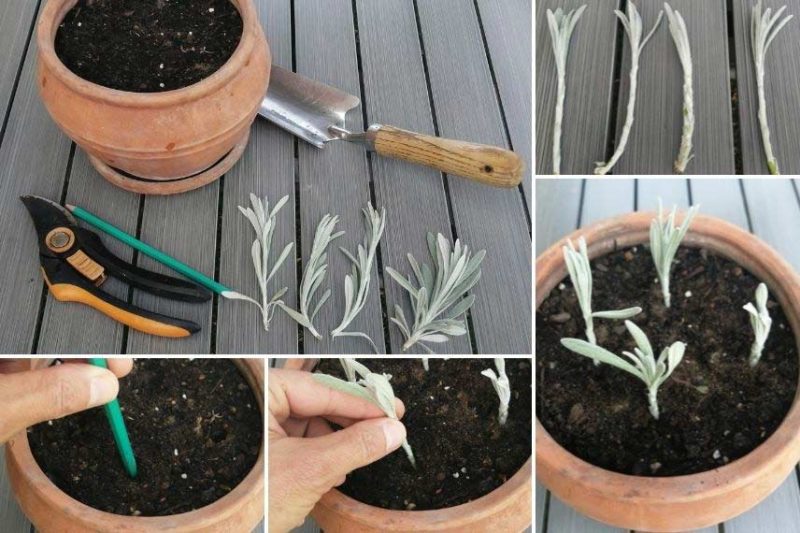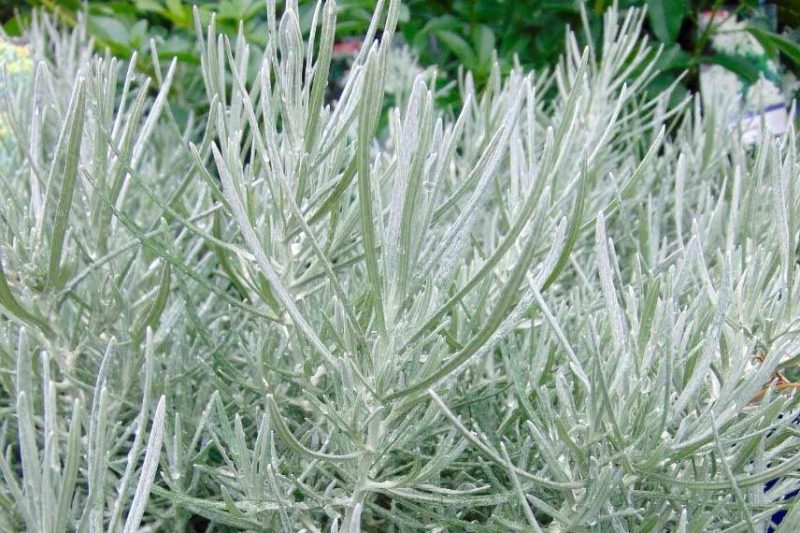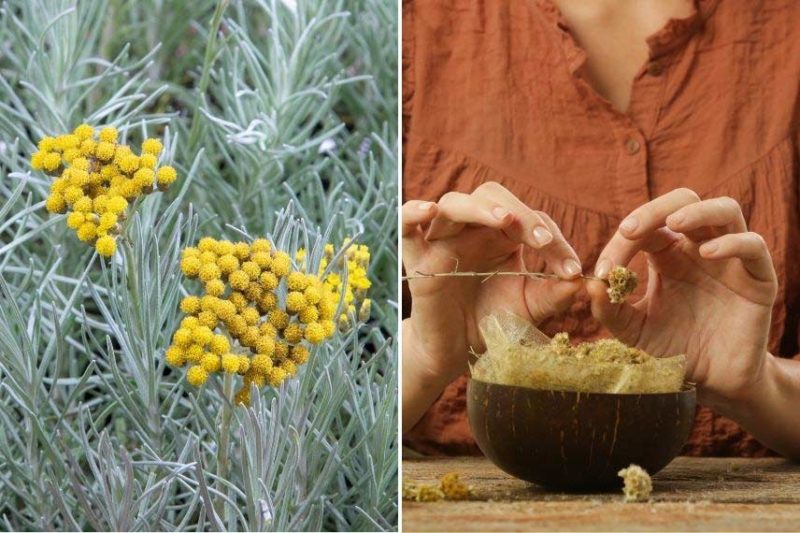Helichrysum, also known as "Immortelle" or "curry plant", is a small Mediterranean perennial. There are also annual varieties: the bracted everlastings (Helichrysum bracteatum).
Helichrysum is valued for its colourful summer flowering, and for silvery, evergreen, aromatic foliage in perennial varieties. Easy to grow and undemanding, Immortelles will thrive in full sun in dry, well-drained soil, even poor, stony soil. These are also plants easy to multiply, whether by cutting, division or sowing.
Discover our advice to succeed in multiplication of Helichrysum and obtain new plants simply and for free.

Immortelle in its natural Mediterranean habitat
For full details on growing Immortelle, see our article: " Helichrysum, curry plant, everlastings: sow, plant, care ".
Propagate Helichrysum by cuttings
Propagation by cuttings is the most effective technique to multiply perennial Helichrysum (Helichrysum italicum, Helichrysum stoechas and Helichrysum petiolare). It recreates an exact clone of the parent plant, called "mother plant". The new plant will therefore share the same genetic characteristics as the source plant.
Simple to succeed and accessible even to beginner gardeners, propagation by cuttings will allow you to obtain quickly and economically several new Immortelle plants.
Required equipment
- A bucket or a pot with drainage holes (conventional plastic or biodegradable)
- A spray bottle for gentle watering
- A pencil or stick to prepare planting holes
- A pruning shear well sharpened and disinfected beforehand to avoid disease transmission
- A light substrate: seed and potting compost, compost for Mediterranean plants or an equal mix of universal compost and sand
When to proceed?
Propagation by cuttings is carried out in summer, from July to September, on semi-woody or semi-ripe shoots. This means stems are no longer very young (green or herbaceous stems) but still somewhat flexible and not fully transformed into hard wood.
Cuttings taken in late spring (May–June) from current-year shoots can also work, but generally have a lower success rate.
How to proceed for Helichrysum cuttings?
- Using pruning shear, take one or several non-flowering shoots from mother plant, about 10 cm long
- Remove leaves from lower two-thirds of stem (area that will be buried): this is called dressing.
- Fill bucket or pot with substrate.
- Moisten substrate with spray bottle, ideally using rainwater.
- Using pencil, make one or several planting holes about 5 cm deep.
- Insert cutting(s) into holes.
- Firm gently with fingers to keep stem upright and remove air pockets.
- Place bucket or pot in a warm spot sheltered from wind, rain and direct sun.

Preparing equipment and cutting stems for cuttings, dressing stems and planting in substrate
Substrate must be kept moist until rooting, after about 3 to 4 weeks. New shoots should then appear, indicating cutting has taken.
To increase chances of success, you can also carry out covered cuttings. Place a clear bag (freezer bag), a cloche or a plastic bottle with base cut off directly over the bucket. This recreates warm, humid conditions favourable to establishment, like a mini greenhouse. Simply remember to ventilate occasionally to remove excess moisture and prevent disease.
Young cut plants should then be moved to a bright position. They should be sheltered throughout winter. Watering should be reduced: always wait until substrate surface is dry.
In spring, once last frost risks have passed, replant Helichrysum cuttings either into a pot at least 30–40 cm diameter, or directly into ground.
Want to learn more about propagation by cuttings? See Alexandra's article: "Propagation by cuttings: everything you need to know about different techniques and our advice".
Divide Helichrysum
Division makes it possible to separate a plant's root system into one or more parts. Separated plants already have their own roots, encouraging re-establishment. Division is done on plants already in place for several years (around 3–4 years). It also rejuvenates plants that are becoming too large or thinning out.
Note that this technique has a lower chance of success than propagation by cuttings. Many Mediterranean plants do not like being moved once established — lavender, rosemary and thyme are examples. For them, relocation is more traumatic than for other species, limiting chances of re-establishment. Immortelle can therefore experience difficulties after division.

Division also rejuvenates Immortelle clumps and provides new plants for the garden
Required equipment
- A spade or digging fork
- A knife well sharpened and disinfected beforehand to avoid disease transmission
- A light substrate: seed and potting compost, compost for Mediterranean plants or an equal mix of universal compost and sand
When to proceed?
Perennial Helichrysum are divided in spring, once last frost risks have passed.
Do not divide in autumn, as wetter soil and conditions tend to weaken roots further.
How to proceed for division of Helichrysum?
If you plan to grow one of the divided parts in a pot, prepare a perforated container about 30–40 cm diameter, filled with substrate and moistened in advance. If planting directly in ground, prepare site beforehand: remove weeds, clear stones, and work soil if needed by lightening it and adding substrate.
- Using spade, lift plant from ground by levering gently, trying to break as few roots as possible.
- Using knife, separate rootball into two parts.
- Replant one half at original location and the other half in pot or in ground.
- Water generously to encourage re-establishment, then regularly for following three weeks to promote root development.
Sow perennial or annual Helichrysum
Sowing is the only way to multiply annual bracted everlastings (Helichrysum bracteatum). But this multiplication method also works easily for perennial varieties.
Sowing is the most natural way to multiply a plant. Although it requires a little more patience, it produces robust new plants and gives satisfaction of watching Helichrysum grow from seed to mature plant.
Required equipment
- A packet of seeds (available in garden centres, specialist shops or online) or seeds previously harvested from garden in previous season
- For sheltered sowing, several perforated buckets or a seed tray
- A spray bottle for gentle watering
- A light substrate: seed and potting compost, compost for Mediterranean plants or an equal mix of universal compost and sand
When to proceed?
Sowing in situ, directly in ground, is done in spring. Wait for temperatures to warm (above about 12 °C) and for last frosts to have passed, usually in April or May depending on region. Note that flowering of bracted everlastings may be delayed in summer if sowing is later.
Sheltered sowing can be started earlier, from February–March. Ideal germination temperature is around 16–20 °C.

Harvesting Immortelle seeds can be done directly in the garden
How to proceed for sowing Helichrysum?
Sheltered
- Fill buckets or seed tray with substrate.
- Sow seeds on surface: a small pinch per bucket, several pinches in tray spread fairly thinly.
- Cover lightly with compost, without burying seeds too deep.
- Moisten generously with spray bottle.
- Place in warm, bright position.
- Keep moist until germination and emergence, usually within 2–3 weeks.
- When seedlings are about 5 cm tall and plants start to crowd, pot on into individual buckets.
- Plant out in ground at end of spring.
In ground
- Prepare area for sowing by removing weeds, clearing stones and lightening soil with substrate.
- Sow seeds broadcast (sprinkle seeds evenly without creating too high a density).
- Cover lightly with compost, without burying seeds too deep.
- Moisten generously with spray bottle.
- Keep moist until germination and emergence.
- Thin out, keeping only strongest plants spaced about 30–40 cm apart (weaker plants can be potted individually or planted elsewhere in garden).
Want to learn more about sowing? See Virginie's article "Sowing annual seeds: how to succeed, in ground or in trays" or Alexandra's article "Succeeding in sowing perennial plants".































![[plant id="helichrysum"]Multiply Helichrysum by division in spring. Dig up the plant and separate the root clumps to create new plants. Replant them in well-draining soil and water thoroughly. propagating sowing dividing everlasting strawflower](https://en.promessedefleurs.eu/blogwp/wp-content/uploads/2022/04/1-1.jpg)
Comments